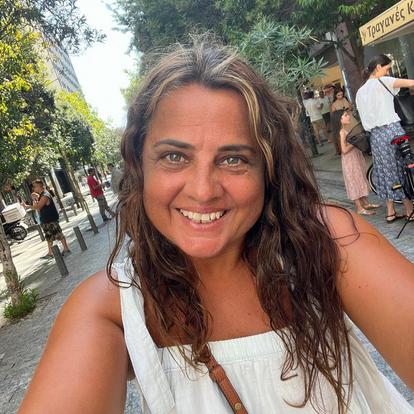
Anastasia "Stacey" Moragiannis

Tell us a little bit about yourself and your diabetes journey
I am an executive assistant for a large Australian retail brand. I have a busy work life and I absolutely love it. I love to travel and sit in the sun especially when Melbourne puts on some great weather. I like to keep active and try to do a five to ten kilometre walk a day and fit in as much resistance training as I can.
I was diagnosed with type 1 diabetes in 1978 when I was six years old. I was brought up by Greek immigrant parents who did everything they could back then to help find a cure despite not being able to speak a word of English. I remember my dad wanting to take me to London for a cure and we even did a road trip together from Adelaide to Sydney to see some therapists. The reality of the situation hit my dad and he struggled to accept that I had an incurable condition. We were told in the early days of my diagnosis that by the time I turn 21 years old that there will be a cure. I’ve been 21 twice now and there’s still no cure.
Navigating my diagnosis at a young age proved challenging to my family, especially for my parents given their limited English, so they didn’t quite understand. At the time they weren’t aware of the impact of carbohydrates to my body, so they focused on removing sugary foods from my diet as per the doctors advised them. So as a child, I just listened to what they said and lived life by what they asked me to do.
Fast forward to my 20s, I started to see an endocrinologist. She advised me to work around my carbohydrate intake and insulin dosages, and that advice changed everything, and how I navigated my diabetes from then on.
How has technology changed living with diabetes?
Growing up, I never spoke about my diabetes. No one knew I had diabetes. I was embarrassed, didn’t want to talk about it and I didn’t want the attention that could come with it. I also didn’t want people to think I was sick. But as time passed and by having access to technology over the years, that all changed. Sometimes I really wish my dad was here to see how far the technology has come with diabetes.
My first encounter with technology is when I met a doctor who said that I was living in dinosaur years, managing my diabetes with syringes. She introduced me to using a glucometer, which back then was such a novelty for me. And because I had to use it during work hours, what my glucometer was telling me about my blood sugar became a conversation starter amongst my colleagues and eventually, what helped me get over feeling embarrassed about my diabetes.
A couple of years later, I was introduced to a Continuous Glucose Monitoring (CGM) device, and this has absolutely changed my life. Firstly, it doesn’t hurt when putting it on as the material is fine and flexible. But importantly, it gives me all the stats and numbers that I need to help me manage my sugar and insulin levels. This new piece of technology has simplified my life. With a quick glance at my phone, I can see where my sugar readings are at, and I can take action if required. Gone are the days of finger pricking and using a glucometer. The CGM is a game changer for any person living with type 1 diabetes. The number of times I had to prick my fingers daily to now just glancing at my phone, this new technology is one of the best things that could have happened in the diabetes world. I just love it so much.
My first encounter with technology is when I met a doctor who said that I was living in dinosaur years, managing my diabetes with syringes. She introduced me to using a glucometer, which back then was such a novelty for me. And because I had to use it during work hours, what my glucometer was telling me about my blood sugar became a conversation starter amongst my colleagues and eventually, what helped me get over feeling embarrassed about my diabetes.
A couple of years later, I was introduced to a Continuous Glucose Monitoring (CGM) device, and this has absolutely changed my life. Firstly, it doesn’t hurt when putting it on as the material is fine and flexible. But importantly, it gives me all the stats and numbers that I need to help me manage my sugar and insulin levels. This new piece of technology has simplified my life. With a quick glance at my phone, I can see where my sugar readings are at, and I can take action if required. Gone are the days of finger pricking and using a glucometer. The CGM is a game changer for any person living with type 1 diabetes. The number of times I had to prick my fingers daily to now just glancing at my phone, this new technology is one of the best things that could have happened in the diabetes world. I just love it so much.
What do you see is lacking when it comes to diabetes?
I do believe there is a lack of awareness about diabetes in society today. There are individuals out there who still believe that cinnamon is going to help treat my diabetes. This is so far from the truth.
Some still don’t understand the difference between the different types of diabetes, or some have the mindset that you did this to yourself to get diabetes. There is still that stigma out there and it just doesn’t seem to be changing.
I believe as a society, we need more focus on diabetes, whether its commercials, radio advertisements, media articles or social media. At the end of the day, people are just not grasping the situation and don’t fully understand how people can live a normal life with diabetes.
Some still don’t understand the difference between the different types of diabetes, or some have the mindset that you did this to yourself to get diabetes. There is still that stigma out there and it just doesn’t seem to be changing.
I believe as a society, we need more focus on diabetes, whether its commercials, radio advertisements, media articles or social media. At the end of the day, people are just not grasping the situation and don’t fully understand how people can live a normal life with diabetes.
What advice would you give someone who was recently diagnosed with diabetes?
The only thing I can say to them is don’t freak out. Don’t let the media or people tell you that you’re going to die. If you don’t monitor it correctly complications can happen but know that you can live your life like any other individual as long as you monitor your diabetes. Ensure you control diabetes, don’t allow it to control you and your mind.
Want to be part of our community?
ALWAYS READ THE LABEL AND FOLLOW THE DIRECTIONS FOR USE. Read the warnings available on dexcom.com/downloadsandguides before purchasing. Consult your healthcare professional to see which product is right for you. Dexcom is a medical device used to continuously measure and record glucose concentrations in diabetic patients.
